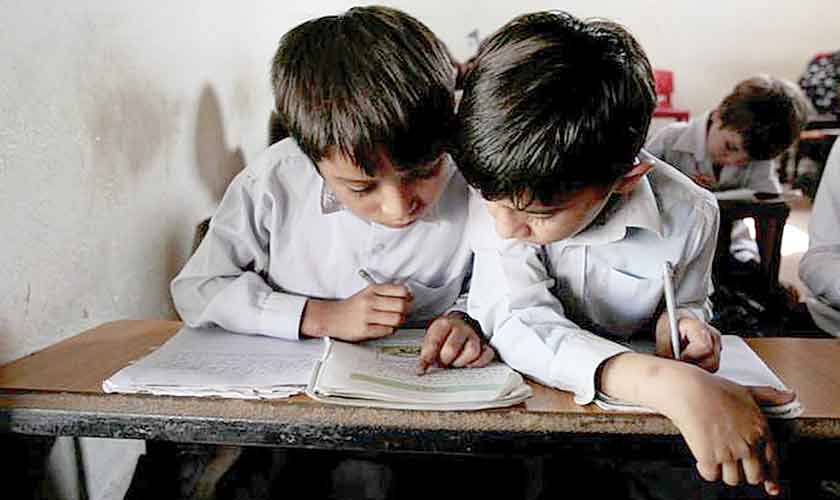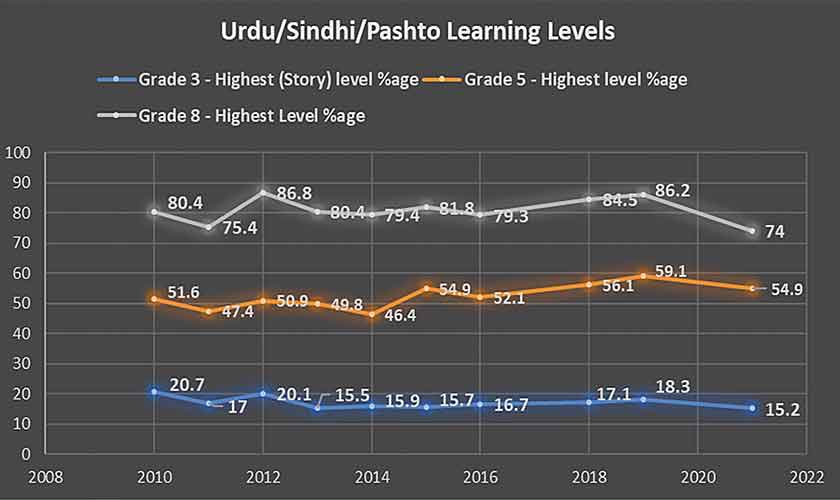narratives of ‘good news’ on this International Day of Education 2023. However, engulfed with chronic woes ailing the fifth most populous country globally, education and learning entitlements of more than 63 million children in Pakistan lie precariously low. How will education as a fundamental constitutional right for 5-16 years old be prioritised amidst complex issues of political instability and polarisation, an election year, precarious economic situation, unprecedented floods with destruction and recovery challenges, climate change crises, mounting insecurity and a very demoralised citizenry. While the odds are stacked against any silver lining for learning recovery amidst a global and national learning crisis and its unequal distribution by area, gender, income and faith, there is every reason to aggressively and collectively find an authentic learning design for project education in Pakistan, a call to action for education transformation to achieve and celebrate Article 25-A and SDG 4.
The movement must have the courage to confront evidence and thinning of the education pyramid, skewed towards high-stake degrees at secondary and tertiary levels to access economic opportunities. This happens at the expense of the majority being excluded and only 24 percent women in the labour force. With 10 percent of tertiary age population entering universities, out of 27 percent students enrolled in matric, 37 percent at middle and 64 percent at primary level, the crisis of access and shriveled tail of learning must be boldly tackled. In almost every government and low-cost private primary school we see a classic 60+ children in pre-school/ ECE (some registered and some not due to low birth registration rates which stand at 44 percent), reducing to 40 in Grade 1, dropping further to up to just 13/ 15 in Grade 5. The lucky ones, who make it to middle school, mostly remain stable up to matric.

What is more tragic is that children in Grade 3 are unable to cope with Grade 2 level basic competencies in literacy and numeracy. ASER Pakistan, Idara-i-Taleem-o-Aagahi’s flagship programme, has time series learning data from 2010-2022 for both in-school and out of school children in foundational learning by age, grade, gender and class (age 5-16/ Grades 1-10). The over 11 years of data for children in Grade 3, assessed for Grade 2 level competencies, reveals that the ability to read a simple story stood at just 20.7 percent in 2010, dipping to 18.3 percent in 2019 and 15.2 percent during the pandemic years (2021). Low learning outcomes in Grade 3 translate into 55 percent children reading the same Grade 2 tool in Grade 5, with only 74 percent in Grade 8 in 2021. The building blocks that children missed out in the foundational years in the 3-8 age bracket (Grade 3) are hard to catch up in Grades 5 and 8. In spite of Nobel prize winner James Heckman’s longitudinal research on 0-8 year-old children on high returns to investment and neuroscience evidence on vibrant brain development over the same years, our homes and schools provide fragmented attention to the youngest, who fight against all odds to persist in schools. Some drop out, others suffer child labour and child marriages. Only about 10 percent end up in tertiary level or TVET.
Must we have a major education and learning default? Must education expenditures remain anemic at 1.99-2.3 percent of the GDP, always under pressure for three out of five years of every democratic political cycle? Can the vicious political economy of the sector be made into a virtuous one? Can we turn around the learning poverty to ensure all 10-year-olds can read a simple paragraph?
The UN secretary general gathered 130 heads of states on the sidelines of the UN General Assembly Transforming Education Summit (TES) 2022 to call for urgent action, where schools are safe and enabling, learning is assured, teachers are supported and teach, technology is encouraged and financing is assured. These five pillars are often reflected in our policies and sector plans but implementation falls very short. The focus is never on foundational learning that combines social emotional stimulation, life skills and care from ECE to Grade 3.
We must work on transformative shifts urgently learning from good examples.
Shift 1: Making foundational learning ages 3-8 a critical well-resourced base for lifelong learning sustained from ECCE to Grade 3 in our education system.
Shift 2: Create delivery units for local village/ union council level diagnostics, planning and action for every child learning foundational literacy and numeracy up to Grade 3 (eventually 5 and 8), resulting in measurable and stunning learning dividends witnessed vividly in the renowned Sobral municipality of Ceará state (9 million) in Brazil. 15 Pakistani Fellows recently visited Sobral for a South South immersion programme, including 8 senior civil servants and influencers from the federation. Sobral, with a low GDP, had topped learning outcomes in a high population country with dysfunctional schools and principals. Its politicians, bureaucrats, citizens, media and experts created a coalition to redesign education for strong learning outcomes. The local ‘education design’ worked wonders with: targeted vision, active leadership, a living curriculum, well supported teachers, learning and remedial routines, engaged parents, inclusive functioning buildings and transparent need-based financing flows to schools for highly visible and agreed success indicators. The ‘learning municipality’ produced public good, and was replicated across Ceará and Brazil. Pakistan must embark on delivery units for systems-based local level planning with devolved authority. There is quality big education data being produced in Pakistan; it must be used by provincial and local level actors for gains in foundational learning.
 Data indicating learning levels of children in Grade 3 assessed for Grade 2 level competencies
Data indicating learning levels of children in Grade 3 assessed for Grade 2 level competenciesShift 3: Use the high family engagement evidenced during Covid-19 in children’s learning, even in the poorest households, bridging the fractured home-school divide through a thriving triad of children, parents and teachers for collaborative learning, resilience and co-creation. Aaj Kya Seekha, a learning campaignon social media, is creating a holistic bond among children, parents and teachers through daily life learning activities with an active growth mind set.
Shift 4: Build on early success of expanded nationwide internet infrastructure, use of Ed Technology, distance/ hybrid learning accelerated during Covid-19 by the government through public private partnerships. More than 1 million teachers have been trained in distance/ hybrid and safe learning, increasing exposure of millions of students and parents through Tele School, SMS, WhatsApp bundles, learning apps and more. The tech pillar must receive progressive investment through public-private partnership financing models to reach the unreached groups in emergencies.
Shift 5: Make social protection, such as the Benazir Income Support Programme, birth registration, and health, nutrition and education, accessible at village/ neighbourhood/ union-council level, achieving multiple fundamental rights and SDGs 2030 targets.
The writer is the CEO of Idara-i-Taleem-o-Aagahi, a Pakistan Learning Festival founder and an Education Commission commissioner. She can be reached at baela.jamilitadec.org




